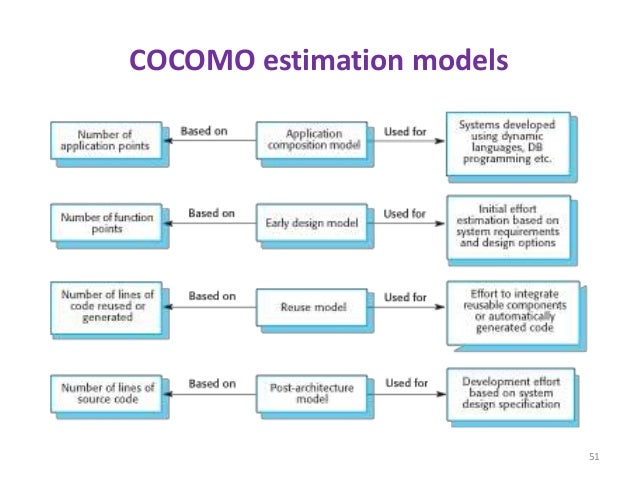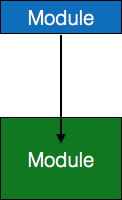Cocomo Model In Software Engineering Tutorial Point
3- Cost reduction: Since software engineering aims to provide cost-effective software. Lily allen full discography torrent. Especially those originated from Barry Boehm's famous COCOMO models. An alternative to direct KSLOC estimating is through function points, then use. The COCOMO II Suite of Software Cost Estimation Models Barry - The COCOMO II Suite. Center for Software.

Features Of Cocomo Model


- Amadeus (1994),Amadeus Measurement System User's Guide, Version 2.3a, Amadeus Software Research, Inc., Irvine, CA.Google Scholar
- Banker, R., R. Kauffman, and R. Kumar (1994), “An Empirical Test of Object-Based Output Measurement Metrics in a Computer Aided Software Engineering (CASE) Environment”,Journal of Management Information Systems, to appear.Google Scholar
- Banker, R., H. Chang, and C. Kemerer (1994a), “Evidence on Economics of Scale in Software Development”,Information and Software Technology, to appear.Google Scholar
- Behrens, C. (1983), “Measuring the Productivity of Computer Systems Development Activities with Function Points”,IEEE Transactions on Software Engineering, November.Google Scholar
- Boehm, B. (1981),Software Engineering Economics, Prentice-Hall.Google Scholar
- Boehm, B. (1983), “The Hardware/Software Cost Ratio: Is It a Myth?”Computer 16, 3, pp. 78–80.Google Scholar
- Boehm, B. (1985), “COCOMO: Answering the Most Frequent Questions”, InProceedings, First COCOMO Users' Group Meeting, Wang Institute, Tyngsboro, MA.Google Scholar
- Boehm, B. (1989),Software Risk Management, IEEE Computer Society Press, Los Alamitos, CA.Google Scholar
- Boehm, B., T. Gray, and T. Seewaldt (1984), “Prototyping vs. Specifying: A Multi-Project Experiment”,IEEE Transactions on Software Engineering, May, 133–145.Google Scholar
- Boehm, B., and W. Royce (1989), “Ada COCOMO and the Ada Process Model”,Proceedings, Fifth COCOMO Users' Group Meeting, Software Engineering Institute, Pittsburgh, PA.Google Scholar
- Chidamber, S., and C. Kemerer (1994), “A Metrics Suite for Object Oriented Design”,IEEE Transactions on Software Engineering, to appear.Google Scholar
- Computer Science and Telecommunications Board (CSTB) National Research Council (1993),Computing Professionals: Changing Needs for the 1990's, National Academy Press, Washington, DC.Google Scholar
- Devenny, T. (1976), “An Exploratory Study of Software Cost Estimating at the Electronic Systems Division”, Thesis No. GSM/SM/765-4, Air Force Institute of Technology, Dayton, OH.Google Scholar
- Gerlich, R., and U. Denskat (1994), “A Cost Estimation Model for Maintenance and High Reuse”,Proceedings, ESCOM 1994, Ivrea, Italy.Google Scholar
- Goethert, W., E. Bailey, and M. Busby (1992), “Software Effort and Schedule Measurement: A Framework for Counting Staff Hours and Reporting Schedule Information”, CMU/SEI-92-TR-21, Software Engineering Institute, Pittsburgh, PA.Google Scholar
- Goudy, R. (1987), “COCOMO-Based Personnel Requirements Model”,Proceedings, Third COCOMO Users' Group Meeting, Software Engineering Institute, Pittsburgh, PA.Google Scholar
- IFPUG (1994),IFPUG Function Point Counting Practices: Manual Release 4.0, International Function Point Users' Group, Westerville, OH.Google Scholar
- Kauffman, R. and R. Kumar (1993), “Modeling Estimation Expertise in Object Based ICASE Environments”, Stern School of Business Report, New York University.Google Scholar
- Kemerer, C. (1987), “An Empirical Validation of Software Cost Estimation Models”,Communications of the ACM, 416–429.Google Scholar
- Kominski, R. (1991),Computer Use in the United States: 1989, Current Population Reports, Series P-23, No. 171, U.S. Bureau of the Census, Washington, DC.Google Scholar
- Kunkler, J. (1983), “A Cooperative Industry Study on Software Development/Maintenance Productivity”, Xerox Corporation, Xerox Square — XRX2 52A, Rochester, NY 14644, Third Report.Google Scholar
- Miyazaki, Y. and K. Mori (1985), “COCOMO Evaluation and Tailoring”,Proceedings, ICSE 8, IEEE-ACM-BCS, London, pp. 292–299.Google Scholar
- Parikh, G. and N. Zvegintzov (1983), “The World of Software Maintenance”,Tutorial on Software Maintenance, IEEE Computer Society Press, pp. 1–3.Google Scholar
- Park, R. (1992), “Software Size Measurement: A Framework for Counting Source Statements”, CMU/SEI-92-TR-20, Software Engineering Institute, Pittsburgh, PA.Google Scholar
- Park, R., W. Goethert, and J. Webb (1994), “Software Cost and Schedule Estimating: A Process Improvement Initiative”, CMU/SEI-94-TR-03, Software Engineering Institute, Pittsburgh, PA.Google Scholar
- Paulk, M., B. Curtis, M. Chrissis, and C. Weber (1993), Capability Maturity Model for Software, Version 1.1”, CMU/SEI-93-TR-24, Software Engineering Institute, Pittsburgh, PA.Google Scholar
- Pfleeger, S. (1991), “Model of Software Effort and Productivity”,Information and Software Technology 33, 3, 224–231.Google Scholar
- Royce, W. (1990), “TRW's Ada Process Model for Incremental Development of Large Software Systems,Proceedings, ICSE 12, Nice, France.Google Scholar
- Ruhl, M. and M. Gunn (1991), “Software Reengineering: A Case Study and Lessons Learned”, NIST Special Publication 500-193, Washington, DC.Google Scholar
- Selby, R. (1988), “Empirically Analyzing Software Reuse in a Production Environment”, InSoftware Reuse: Emerging Technology, W. Tracz, Ed., IEEE Computer Society Press, pp. 176–189.Google Scholar
- Selby, R., A Porter, D. Schmidt, and J. Berney (1991), “Metric-Driven Analysis and Feedback Systems for Enabling Empirically Guided Software Development”,Proceedings of the Thirteenth International Conference on Software Engineering (ICSE 13), Austin, TX, pp. 288–298.Google Scholar
- Silvestri, G. and J. Lukasiewicz (1991), “Occupational Employment Projections”,Monthly Labor Review 114, 11, 64–94.Google Scholar
- SPR (1993), “Checkpoint User's Guide for the Evaluator”, Software Productivity Research, Inc., Burlington, MA.Google Scholar